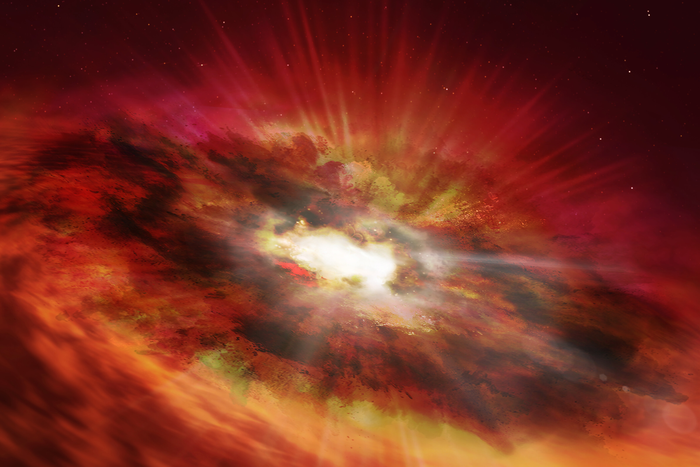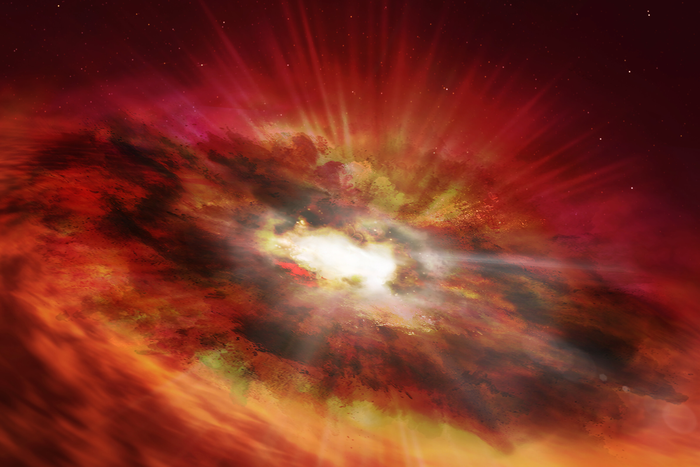Hubble Find Provides Key to Early Supermassive Black Holes
For modern astronomers, one big enduring mystery is how supermassive black holes formed in the earliest epochs of the Universe. Quasars—luminous objects that came into being just several hundred million years after the big bang—are thought to be powered by supermassive black holes. But current models call into question how the gargantuan black holes that power those quasars could have formed so rapidly in the early Universe. Now, Seiji Fujimoto of the Cosmic Dawn Center, Denmark, and colleagues have found a quasar that they say might verify one model for the formation of the first supermassive black holes [1]. The team believe that this type of quasar could be more common than previously thought.
The team uncovered the quasar, named GNz7q, in archival data from NASA’s Hubble Space Telescope. Data indicate that GNz7q originated 750 million years after the big bang, during the so-called cosmic dawn—the time when the Universe’s first stars and galaxies formed.
In the Hubble data, GNz7q appears as a low-luminosity blob. Using data from the Chandra X-ray Observatory, the team observed that the quasar faintly emits x rays. This signature goes counter to characteristics seen in most other quasars: typically, quasars are strong x-ray emitters and are among the brightest objects in the Universe. The unexpected spectral signature of GNz7q can be explained by the presence of dust surrounding the supermassive black hole thought to power this quasar, Fujimoto says, leading the team to conclude that GNz7q is also likely dust obscured. Fujimoto adds that astronomers have long predicted the existence of old, dusty quasars such as GNz7q, but until now, none had been found.
So why all the excitement about a dirty quasar? Simulations of the early Universe indicate that when the first galaxies started merging, the gas they contained compressed to form new stars. As these stars were born, other stars died in supernova explosions. These supernovae stirred up the nearby gas, sending it falling into the galaxies’ central black holes. Astronomers believe this process did three things to those galaxies: provided the matter needed to turn their central black holes supermassive, enveloped each galaxy in dust, and provided the conditions needed to develop quasars like GNz7q. Observing a dusty quasar thus provides a crucial key in confirming this hypothesis of how supermassive black holes formed, Fujimoto says.
This observation provides strong evidence that supermassive black holes were forming at the beginning of the Universe, says Chris Willott, an astronomer at the National Research Council of Canada. He also thinks that the finding suggests that there were probably a lot more supermassive black holes at that time than researchers have previously thought.
Fujimoto agrees. Hubble spotted GNz7q in the GOODS North field, a small but popular area of the night sky used for astronomy surveys. Statistically, if dusty quasars are rare, it’s unlikely that one would have been found in such a small survey, Fujimoto says. That it has been spotted indicates there should exist many more quasars like GNz7q—and thus many accompanying supermassive black holes.
Using NASA’s recently launched James Webb Space Telescope, both Fujimoto and Willott think that researchers should be able to discover more dusty quasars, something that they say would improve understanding about the growth of the accompanying supermassive black holes. “This kind of big discovery might be always hidden just in front of us,” says Fujimoto.
–Allison Gasparini
Allison Gasparini is a freelance science writer based in Santa Cruz, CA.
References
- S. Fujimoto et al., “A dusty compact object bridging galaxies and quasars at cosmic dawn,” Nature 604, 261 (2022).





